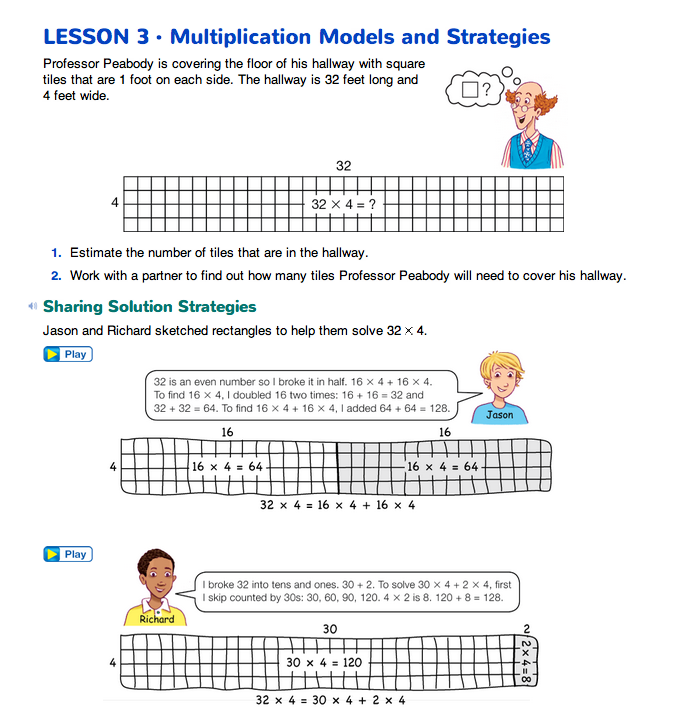Direct students' attention to the Multiplication Models and Strategies pages in the Student Guide. Professor Peabody is tiling a 32 × 4 foot rectangular hallway. In Questions 1–2, students are asked to work with a partner to find out how many square foot tiles he will need to cover the hallway.
- Before you begin to answer Questions 1 and 2, talk with your partner. What are some different ways you can divide the rectangle into two parts?
- Does one way of breaking the rectangles into parts make the problem easier to solve than another way?
Show students how to sketch a 32 × 4 rectangle to help them solve the problem. See Figure 1. Assign Questions 1–2 and ask students to work in pairs to first estimate and then find the number of tiles in Professor Peabody's hallway. As pairs work together, encourage them to use their own methods. Monitor their work and note the strategies that they use.
Display the Professor Peabody's Hallway Master and have students share their estimation and solution strategies for Questions 1–2.
Ask questions similar to the following to generate discussion:
- How did you estimate the number of tiles in the hallway? (Possible response: I multiplied 30 × 4, so an answer of around 120 would be reasonable.)
- Did you break the rectangle into smaller rectangles to make it easier to find the total number of small squares? If so, how? (Answers will vary. Possible response: I made a rectangle for 30 × 4 and one for 2 × 4. See Figure 2.)
- Write a number sentence for the part that matches the smaller rectangle and one for the larger rectangle. (Answers will vary. Possible response: 4 × 2 = 8 and 4 × 30 = 120)
- Show on the display how the numbers in the number sentences match with the rows and the number of squares in each row.
- How did you find the total number of squares? Write a number sentence that shows you added the two parts together. (Strategies will vary. Possible response: I broke the 32 into tens and ones. 4 times 3 tens is 120. 4 times 2 ones is 8. 120 + 8 = 128. 4 × 30 + 4 × 2 = 128.)
- Did anyone solve the problem differently? Explain.
After sharing strategies with the class, read the Sharing Solution Strategies section of the Multiplication Models and Strategies pages together. Two solution strategies are discussed: Jason's strategy breaks the rectangle in half and Richard's strategy breaks the product into tens and ones.
- Did anyone use a strategy like Jason's? How did this make solving the problem easier? (Possible response: It was easier for me to break 32 in half and then use doubling than to multiply 32 × 4.)
- Did anyone break the product into tens and ones like Richard?
- Was one way easier to use than the other? Why? (Possible response: Breaking a factor so that one of its parts is a multiple of ten makes the multiplication easier.)














